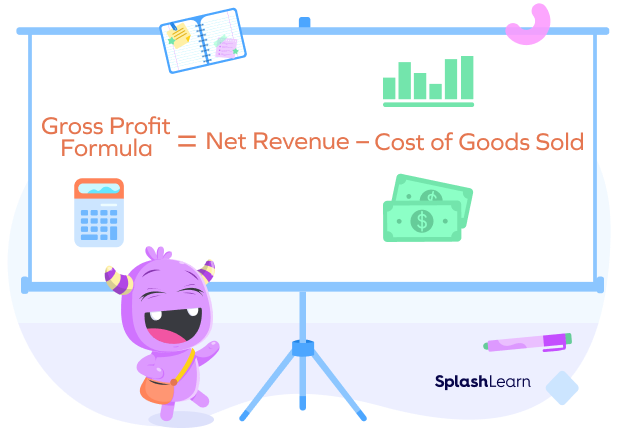What Is the Gross Profit Formula?
The gross profit formula is used to calculate the gross profit of a company or a business, which is calculated by subtracting the cost of goods sold (COGS) from the total revenue.
Let’s first understand these two terms: total revenue and COGS.
- Total Revenue: This is the total amount of money generated from sales or services provided by the company during a specific period. It is the revenue generated by a company without subtracting the costs or losses associated.
- Cost of Goods Sold (COGS): This represents the direct costs associated with producing or acquiring the goods that were sold. It includes expenses such as raw materials, direct labor costs, and manufacturing overhead. COGS refers to the direct costs of producing the goods (cost the company bears in making and selling the goods).
Recommended Games
Gross Profit Formula
The formula to calculate gross profit is given by
| Gross Profit = Net Revenue – Cost of Goods Sold (COGS) |

Now, let’s understand how to find the gross profit.
How to Calculate Gross Profit
To calculate gross profit using the formula provided, you can follow these steps:
Step 1: Determine the Total Revenue
Identify the total amount of revenue generated by the company during a specific period. This includes all sales or services provided by the company.
Step 2: Determine the Cost of Goods Sold (COGS)
Identify the direct costs associated with producing or acquiring the goods that were sold during the same period. This includes expenses such as raw materials, direct labor costs, and manufacturing overhead.
Step 3: Subtract the COGS from the Total Revenue
Subtract the COGS value obtained in Step 2 from the total revenue obtained in Step 1. This calculation will give you the gross profit.
Gross Profit = Total Revenue – Cost of Goods Sold (COGS)
The resulting value will represent the amount of money left after covering the direct costs of production or acquisition. This value is the gross profit, which can be used to evaluate the profitability of the company’s core operations.
Let’s take an example to understand this better!
Manny is running a lemonade stand. He earned $40 on a particular day from selling lemonade.
The cost of the lemons, sugar, cups, and other ingredients used to make the lemonade amounts to $15.

Now, let’s calculate the gross profit he made using the formula:
Gross Profit $=$ Total Revenue – Cost of Goods Sold (COGS)
Gross Profit $= \$40 \;-\; \$15$
Gross Profit $= \$25$
This means that after deducting the cost of ingredients, Manny made a profit of $25.
The gross profit formula is a great way to determine how much money is left over after subtracting the direct costs associated with producing or acquiring the goods that were sold.
Gross Profit Margin
Gross profit margin is a financial metric that measures the profitability and efficiency of a company’s operations by expressing its gross profit as a percentage of its total revenue.
It indicates how much profit a company generates from each dollar of revenue after deducting the cost of goods sold (COGS).
Gross margin is simply the gross profit divided by the total revenue, multiplied by 100. The formula for calculating gross profit margin is:
Gross Profit Margin $= (\frac{Gross\; Profit}{Total\; Revenue}) \times 100$
Gross profit margin is an important indicator of a company’s ability to generate profit from its core operations.
A higher gross profit margin suggests that the company is effectively managing its production costs and generating more profit per dollar of revenue. On the other hand, a lower gross profit margin may indicate higher production costs or pricing challenges.
Facts about Gross Profit Formula
- Gross Profit $=$ Total Revenue – Cost of Goods Sold (COGS).
- Gross margin is another metric to define gross profit. It is represented as a percentage. It is calculated by dividing gross profit by total revenue and multiplying by 100.
- Gross profit is a key financial metric used by investors, analysts, and business owners to evaluate the profitability and efficiency of a company’s production or sales processes.
- While gross profit is an important measure, it does not take into account other expenses such as operating expenses, interest, and taxes. To assess overall profitability, net profit, which considers all expenses, must be considered.
Conclusion
In this article, we have learned about the gross profit formula. Gross profit serves as a tool for management to monitor and optimize the efficiency of the production or sales process, as well as to make informed decisions regarding pricing, cost control, and product mix. Let’s solve some examples and practice problems to understand it better.
Solved Examples on Gross Profit Formula
1. ABC Company had total revenue of $\$800,000$ in 2020 and a cost of goods sold (COGS) of $\$400,000$. Calculate the gross profit.
Solution:
Total revenue $= \$800,000$
cost of goods sold (COGS) $= \$400,000$
Gross Profit $=$ Total Revenue $-$ COGS
Gross Profit $= \$800,000 \;-\; \$400,000$
Gross Profit $= \$400,000$
The Gross Profit of ABC Company is $\$400,000$
2. XYZ Corporation generated a gross profit of $\$120,000$ with a total revenue of $\$500,000$. Find the gross profit margin.
Solution:
Gross Profit $= \$120,000$
Total Revenue $= \$500,000$
Gross Profit Margin $= (\frac{Gross \;Profit}{Total\; Revenue})\times 100$
Gross Profit Margin $= (\frac{120,000}{500,000})\times 100$
Gross Profit Margin $= (\frac{12}{50}) \times 100$
Gross Profit Margin $= 0.24 \times 100$
Gross Profit Margin $= 24\%$
3. A retail store’s total revenue is $\$800,000$, and the gross profit margin is $40\%$. Determine the gross profit.
Solution:
Total revenue of the store $= \$800,000$
Gross profit margin is $40\%$
Gross Profit Margin $= (\frac{Gross \;Profit}{Total \;Revenue}) \times 100$
Thus, Gross Profit $=$ Gross Profit Margin $\times$ Total Revenue
Gross Profit $= 0.40 \times \$800,000$
Gross Profit $= \$320,000$
4. Company XYZ has a gross profit of $\$50,000$ and a gross profit margin of $20\%$. Calculate the total revenue.
Solution:
Gross Profit $= \$50,000$
Gross profit margin $= 20\%$ or 0.20
Gross Profit Margin $= (\frac{Gross\; Profit}{Total\; Revenue}) \times 100$
Thus,
Total Revenue $= (\frac{Gross\; Profit}{Gross \; Profit \; Margin})$
Total Revenue $= \frac{50,000}{0.20}$
Total Revenue $= \$250,000$
5. The cost of a car is $\$300,000$. It is sold at $\$500,000$. Calculate the gross profit and gross profit margin.
Solution:
Total Revenue $= \$500,000$
Cost of goods sold (COGS) $= \$300,000$
Gross Profit:
Gross Profit $=$ Total Revenue $-$ COGS
Gross Profit $= \$500,000 \;-\; \$300,000$
Gross Profit $= \$200,000$
Gross Profit Margin:
Gross Profit Margin $= (\frac{Gross \;Profit}{Total \;Revenue}) \times 100$
Gross Profit Margin $= (\frac{200,000}{500,000}) \times 100$
Gross Profit Margin $= 40\%$
Practice Problems on Gross Profit Formula
Gross Profit Formula: Definition, Concept, Facts, Examples, FAQs
What is the formula for calculating gross profit?
To find gross profit, subtract the cost of goods sold from the total revenue.
Which of the following statements best defines gross profit?
Gross profit represents the profit left after subtracting the cost of goods sold (COGS) from the total revenue.
If a house bought at $\$100,000$ is sold at $\$250,000$, what is the gross profit?
Gross profit $= \$250,000 \;-\; \$100,000 = \$150,000$
What does a higher gross profit margin indicate?
A higher gross profit margin indicates that a company is able to generate more profit from its core operations after accounting for the cost of goods sold.
Frequently Asked Questions about Gross Profit Formula
What does the gross profit represent?
Gross profit represents the amount of money left over after deducting the direct costs associated with producing or acquiring the goods sold.
How is gross profit different from net profit?
Gross profit only considers the direct costs of production or acquisition, while net profit takes into account all operating expenses, interest, and taxes.
How is gross profit different from gross margin?
Gross profit is the actual monetary value obtained by subtracting the cost of goods sold from total revenue, while gross margin is expressed as a percentage and is calculated by dividing gross profit by total revenue and multiplying by 100.
What is the significance of gross profit margin?
Gross profit margin is the ratio of gross profit to total revenue, expressed as a percentage. It helps evaluate the profitability and cost structure of a company’s operations.
Can gross profit be negative?
No, gross profit cannot be negative. If the cost of goods sold exceeds the total revenue, the result would be a negative gross profit, indicating a loss.
Is gross profit the same as gross revenue?
No, gross profit and gross revenue are not the same. Gross revenue refers to the total amount of money generated from sales or services, while gross profit is the amount left after subtracting the cost of goods sold.

















